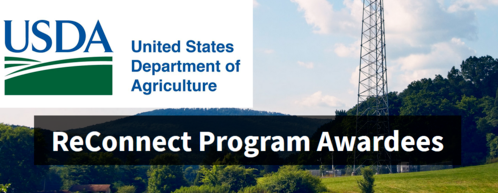
Fast, affordable Internet access for all.

When a $25 million broadband funding award for the Colorado River Indian Tribe (CRIT) was announced in July 2023, CRIT Chairwoman Amelia Flores celebrated it as a “game changer.”
“Broadband access is essential,” Flores’s statement read, making “remote learning, telecommuting, conducting business, and simplifying staying connected” possible.
Coming amid a rolling series of announcements from the Tribal Broadband Connectivity Program – each lauding millions of dollars in broadband funding for Tribes – it would have been easy to file away CRIT’s award as another from that pathbreaking broadband funding program for Tribes.
But this was not the TBCP. Rather, CRIT was among a handful of Tribes that received substantial funding awards from another federal source that has recently stepped up their grantmaking to Tribes – the U.S. Department of Agriculture’s (USDA) ReConnect Grant Program, administered by the department’s Rural Utilities Service (RUS).

CRIT’s award is a helpful reminder that TBCP is not the be-all-end-all of funding for Tribal broadband. With an award cycle now open, ReConnect offers powerful tools and incentives – including dedicated Tribal funding, 100 percent grants, and consent for any new infrastructure on sovereign lands – for Tribes looking to expand or launch broadband service.
TBCP, ReConnect, and Federal Funding for Tribal Broadband Infrastructure
For now at least, March 22nd marked the close of the TBCP, the single largest federal broadband funding program for Tribes. When round two awardees for the TBCP are announced later this year or the next, the National Telecommunications and Information Administration (NTIA) will have disbursed a total of nearly $3 billion over the last three years. But, given that applications in TBCP’s first round alone totaled $6 billion in requests, and round two applications likewise totaling nearly three times the available amount, no one expects this to be enough to close the connectivity gap on Tribal lands. It will remain important for Tribes to look elsewhere – like ReConnect – for infrastructure funds to continue moving their broadband plans forward.
For many Tribal communities, there are a number of reasons why infusions of federal and state grant funds are especially important to get large broadband projects off the ground.
Due to long-term patterns of digital redlining, Tribal lands are often further away from meaningful backhaul connections and sometimes lack much in the way of existing telecommunications infrastructure.

Given the low population density in rural areas, including many Tribal communities, return on investment for building to these areas is often lower, a fact that large ISPs have long used to justify failing to build there.
And because of often limited tax bases and restrictions on using trust land as collateral, many Tribal Nations find it difficult to secure large sums for infrastructure in the way that municipalities or counties might.
All of this makes the barrier for entering broadband potentially prohibitive for many Tribes without outside funding.
While TBCP was one of the only federal broadband funding programs exclusively for Tribes, it is not the only avenue for federal support available. As the Colorado River Indian Tribe’s story illustrates, the USDA’s ReConnect program has emerged over the past few years as one such avenue. Though ReConnect funds are never likely to match the scale or magnitude of TBCP’s grantmaking, the program’s policies around Tribal deployment and ongoing grant cycles make it a potentially lucrative opportunity.
The ReConnect program (formally named the Rural eConnectivity Pilot Program) is funded through a combination of annual appropriations and one-time legislation like the CARES Act and the Infrastructure Investment and Jobs Act (IIJA). It offers a range of award types – 100 percent grants, 100 percent loans, and 50/50 Loan/Grant Combinations – and must serve rural, mostly unserved areas.
With the announcement of the final tranche of awards for Round 4 (FY 2023) in February, the program had disbursed more than $1.8 billion in that cycle alone. (ReConnect 3 and 4 were unusually large because of infusions from IIJA and CARES). In total, ReConnect has awarded more than $5 billion in funding over four cycles.

More to the point, recent award cycles have made more substantial investments in Tribal broadband projects, a welcome pivot that suggests a growing interest in the work on the part of RUS.
Such projects were barely a blip in the first two rounds of ReConnect – amounting to little more than 1 percent of the total amounts awarded, and only 3 out of 173 projects. In contrast, Round 3, started during FY 2022, awarded Tribes 7 percent of the awards and 8 percent of the funding.
Those numbers increased even more in Round 4, with a total of over $200 million going to nine Tribes or Alaska Native entities, representing about 11 percent of the funding total and 10 percent of the projects. And the awards were substantial. CRIT’s grant, for instance, would have put it near the top of TBCP awards in terms of size. (Several other awards funded projects in Tribal and Alaska Native Village Statistical Areas by third party providers).

The increase of funding to Tribal Governments beginning in Round 3 correlates with RUS’s efforts to integrate “guiding principles for federal infrastructure on Tribal Lands” in line with many best practices advanced by Tribal broadband interest groups and Tribal representatives in consultations.
At that point, ReConnect strengthened and clarified Tribal consent policies, requiring formal Tribal Government resolutions of consent for any proposals seeking to build on or over tribal lands.
ReConnect 3 also introduced a 100 percent grant set aside, at the time for Tribal Governments and Socially Vulnerable communities (now defined a bit more broadly). This portion of the program’s grant funds no longer required a match. Finally, with ReConnect 3, RUS began allowing Tribal Governments to self-certify the served status of their lands, with the federal agency then working to “verify” this status.
Taken together, this set of policies sought to address barriers to Tribal participation in ReConnect, though the ReConnect application process remains complex and technically demanding.
Still, the policy changes have made ReConnect a viable option for Tribes at varying stages of broadband development. Rounds 3 and 4 saw awards go to expand established Tribal telcos like C.R.S.T.T.A. and Tohono O’odham Utility Authority; launch new Tribal networks, like the Colorado River Indian Tribes’ project and Oglala Lakota Network; and support Tribes like the Chickasaw and Choctaw Nations grow what look to be nascent or institutional networks into community-wide enterprises.
ReConnect Round 5 Now Open With $700 Million Available
These are hopeful signs as Tribal nations look to the next round of ReConnect dollars. Hot on the heels of TBCP round 2, ReConnect Round 5 is open now, and will accept applications through May 21. With $700 million total available, Round 5’s funding is substantially lower than in the past few years, but it still represents a significant opportunity.
Up to $150 million of that funding is earmarked for Alaska Native Corporations, Tribal Governments, Colonias, Persistent Poverty Areas and Socially Vulnerable Communities, with maximum awards of $25 million and no match required. Tribal Governments can compete for other segments of this $700 million, including another $150 million in grant money, though this pot would require a 25 percent match. Loans and loan-grant combinations are also available, and have been used by Tribes in past rounds.

One important thing to note: areas that have received previous funding through USDA can be funded again through ReConnect 5 if they currently “do not have sufficient access to broadband” after project completion.
Tribal engagement best practices – like consent requirements, self-certification, and match waivers, introduced in Round 3 – are again in force for Round 5. Additionally, the scoring criteria incentivizes Tribal applicants. Tribal Governments (or wholly-owned entities) seeking to serve an area of which at least 75 percent is Tribal lands will receive 15 points during evaluation. In addition, Tribal Governments qualify for an additional 15 points as a unit of government, non-profit, or cooperative.
Competition for a comparatively lower funding allocation will be fierce, but these eligibility and evaluation criteria should put Tribes in a position to compete. In the face of longstanding concerns about Tribes’ access to BEAD dollars, programs like ReConnect that are looking to facilitate Tribal participation (and potentially existing state grants) will be even more important to ensure everyone has access to reliable high-speed Internet.
